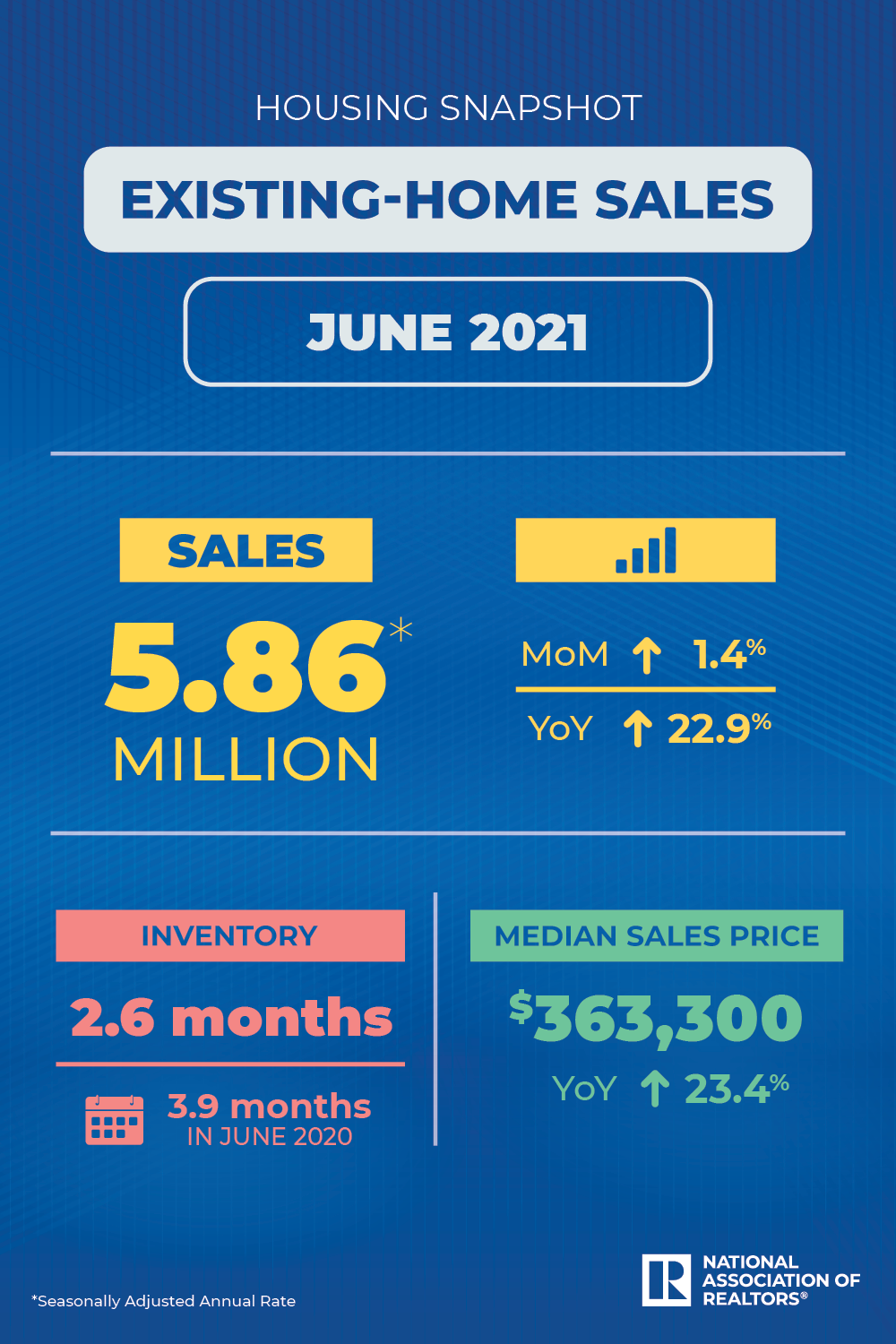Following four consecutive months of declines, existing-home sales bounced back in June, increasing 1.4% from May to a seasonally adjusted annual rate of 5.86 million, according to the latest data from the National Association of REALTORS® (NAR).
Single-family home sales decreased to a seasonally adjusted annual rate of 5.14 million in June, up 1.4% from 5.07 million in May and up 19.3% YoY. The median existing single-family home price was $370,600 in June, up 24.4% from June 2020.
Existing condo and co-op sales posted a seasonally adjusted annual rate of 720,000 units in June, up from 710,000 in May and up 56.5% YoY. The median existing condo price was $311,600 in June—an annual increase of 19.1%.
Three of the four major U.S. regions posted small month-over-month increases, while the South remained flat. However, all four areas experienced double-digit YOY growth.

By Region:
Midwest
Existing-Home Sales: 1.33 million (+18.8% YoY)
Median Price: $278.700 (+18.5% YoY)
Northeast
Existing-Home Sales: 740,000 (+45.1% YoY)
Median Price: $412,800 (+23.6% YoY)
South
Existing-Home Sales: 2.59 million (+19.4% YoY)
Median Price: $311,600 (+21.4% YoY)
West
Existing-Home Sales: 1.20 million (+23.7% YoY)
Median Price: $507,000 (+17.6% YoY)
What it means:
“Supply has modestly improved in recent months due to more housing starts and existing homeowners listing their homes, all of which has resulted in an uptick in sales,” said Lawrence Yun, NAR’s chief economist. “Home sales continue to run at a pace above the rate seen before the pandemic.”
“At a broad level, home prices are in no danger of a decline due to tight inventory conditions, but I do expect prices to appreciate at a slower pace by the end of the year,” Yun said. “Ideally, the costs for a home would rise roughly in line with income growth, which is likely to happen in 2022 as more listings and new construction become available.”
“Huge wealth gains from both housing equity and the stock market have nudged up all-cash transactions, but first-time buyers who need mortgage financing are being uniquely challenged with record-high home prices and low inventory,” Yun added. “Although rates are favorably low, these hurdles have been overwhelming to some potential buyers.”
“NAR continues our conversations with policymakers and leaders from across the industry in an effort to boost housing inventory and increase access to safe, affordable housing for all Americans,” said NAR President Charlie Oppler. “As the nation’s economy continues to recover from COVID-19, securing policies that are in the best interest of U.S. consumers and homeowners remains NAR’s priority.”
“As we approach the late summer, the months ahead hold critical clues into the housing market’s post-pandemic future,” said realtor.com® Chief Economist Daniella Hale. “If sales maintain recent momentum, even as inventory rises, it should help bolster builder confidence and convince them that high demand for housing is not a short-term phenomenon. This should also ultimately lead to more construction and put a bigger dent in the ongoing shortage of homes for sale. But if home sales slip, perhaps due to households prioritizing other spending categories that were neglected during the pandemic, builders may proceed more cautiously.”
“The existing-home sales report for June brought some positive news for the housing market. Sales increased 1.4%, ending a four-month streak of declines, and there was an improvement in the very tight supply conditions seen over the past year,” said Mortgage Bankers Association AVP of Economic and Industry Forecasting Joel Kan. “Inventory increased 3% last month, helped by more homeowners listing their home for sale. Additional data from the U.S. Census Bureau yesterday showed that the homebuilding sector is also trying to keep up with demand.”
“However, the median sales price jumped 23% from a year ago to $363,300—setting another record high,” added Kan. “This is an indication that affordability challenges persist for many potential buyers. Our data on mortgage applications show that purchase activity has moved lower since March, while the average loan size has stayed elevated, consistent with the elevated share of all-cash sales and higher median prices reported by NAR.”
For more information, please visit www.nar.realtor.













Thanks for the great info and the format- Makes it easy to use in reporting, dialogue and tracking our market!!